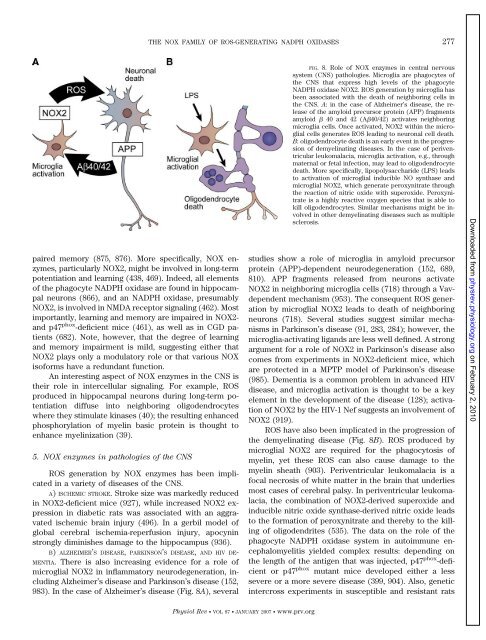Karen Bedard and Karl-Heinz Krause
Karen Bedard and Karl-Heinz Krause
Karen Bedard and Karl-Heinz Krause
Create successful ePaper yourself
Turn your PDF publications into a flip-book with our unique Google optimized e-Paper software.
paired memory (875, 876). More specifically, NOX enzymes,<br />
particularly NOX2, might be involved in long-term<br />
potentiation <strong>and</strong> learning (438, 469). Indeed, all elements<br />
of the phagocyte NADPH oxidase are found in hippocampal<br />
neurons (866), <strong>and</strong> an NADPH oxidase, presumably<br />
NOX2, is involved in NMDA receptor signaling (462). Most<br />
importantly, learning <strong>and</strong> memory are impaired in NOX2<strong>and</strong><br />
p47 phox -deficient mice (461), as well as in CGD patients<br />
(682). Note, however, that the degree of learning<br />
<strong>and</strong> memory impairment is mild, suggesting either that<br />
NOX2 plays only a modulatory role or that various NOX<br />
isoforms have a redundant function.<br />
An interesting aspect of NOX enzymes in the CNS is<br />
their role in intercellular signaling. For example, ROS<br />
produced in hippocampal neurons during long-term potentiation<br />
diffuse into neighboring oligodendrocytes<br />
where they stimulate kinases (40); the resulting enhanced<br />
phosphorylation of myelin basic protein is thought to<br />
enhance myelinization (39).<br />
5. NOX enzymes in pathologies of the CNS<br />
ROS generation by NOX enzymes has been implicated<br />
in a variety of diseases of the CNS.<br />
A) ISCHEMIC STROKE. Stroke size was markedly reduced<br />
in NOX2-deficient mice (927), while increased NOX2 expression<br />
in diabetic rats was associated with an aggravated<br />
ischemic brain injury (496). In a gerbil model of<br />
global cerebral ischemia-reperfusion injury, apocynin<br />
strongly diminishes damage to the hippocampus (936).<br />
B) ALZHEIMER’S DISEASE, PARKINSON’S DISEASE, AND HIV DE-<br />
MENTIA. There is also increasing evidence for a role of<br />
microglial NOX2 in inflammatory neurodegeneration, including<br />
Alzheimer’s disease <strong>and</strong> Parkinson’s disease (152,<br />
983). In the case of Alzheimer’s disease (Fig. 8A), several<br />
THE NOX FAMILY OF ROS-GENERATING NADPH OXIDASES 277<br />
Physiol Rev VOL 87 JANUARY 2007 www.prv.org<br />
FIG. 8. Role of NOX enzymes in central nervous<br />
system (CNS) pathologies. Microglia are phagocytes of<br />
the CNS that express high levels of the phagocyte<br />
NADPH oxidase NOX2. ROS generation by microglia has<br />
been associated with the death of neighboring cells in<br />
the CNS. A: in the case of Alzheimer’s disease, the release<br />
of the amyloid precursor protein (APP) fragments<br />
amyloid � 40 <strong>and</strong> 42 (A�40/42) activates neighboring<br />
microglia cells. Once activated, NOX2 within the microglial<br />
cells generates ROS leading to neuronal cell death.<br />
B: oligodendrocyte death is an early event in the progression<br />
of demyelinating diseases. In the case of periventricular<br />
leukomalacia, microglia activation, e.g., through<br />
maternal or fetal infection, may lead to oligodendrocyte<br />
death. More specifically, lipopolysaccharide (LPS) leads<br />
to activation of microglial inducible NO synthase <strong>and</strong><br />
microglial NOX2, which generate peroxynitrate through<br />
the reaction of nitric oxide with superoxide. Peroxynitrate<br />
is a highly reactive oxygen species that is able to<br />
kill oligodendrocytes. Similar mechanisms might be involved<br />
in other demyelinating diseases such as multiple<br />
sclerosis.<br />
studies show a role of microglia in amyloid precursor<br />
protein (APP)-dependent neurodegeneration (152, 689,<br />
810). APP fragments released from neurons activate<br />
NOX2 in neighboring microglia cells (718) through a Vavdependent<br />
mechanism (953). The consequent ROS generation<br />
by microglial NOX2 leads to death of neighboring<br />
neurons (718). Several studies suggest similar mechanisms<br />
in Parkinson’s disease (91, 283, 284); however, the<br />
microglia-activating lig<strong>and</strong>s are less well defined. A strong<br />
argument for a role of NOX2 in Parkinson’s disease also<br />
comes from experiments in NOX2-deficient mice, which<br />
are protected in a MPTP model of Parkinson’s disease<br />
(985). Dementia is a common problem in advanced HIV<br />
disease, <strong>and</strong> microglia activation is thought to be a key<br />
element in the development of the disease (128); activation<br />
of NOX2 by the HIV-1 Nef suggests an involvement of<br />
NOX2 (919).<br />
ROS have also been implicated in the progression of<br />
the demyelinating disease (Fig. 8B). ROS produced by<br />
microglial NOX2 are required for the phagocytosis of<br />
myelin, yet these ROS can also cause damage to the<br />
myelin sheath (903). Periventricular leukomalacia is a<br />
focal necrosis of white matter in the brain that underlies<br />
most cases of cerebral palsy. In periventricular leukomalacia,<br />
the combination of NOX2-derived superoxide <strong>and</strong><br />
inducible nitric oxide synthase-derived nitric oxide leads<br />
to the formation of peroxynitrate <strong>and</strong> thereby to the killing<br />
of oligodendrites (535). The data on the role of the<br />
phagocyte NADPH oxidase system in autoimmune encephalomyelitis<br />
yielded complex results: depending on<br />
the length of the antigen that was injected, p47 phox -deficient<br />
or p47 phox mutant mice developed either a less<br />
severe or a more severe disease (399, 904). Also, genetic<br />
intercross experiments in susceptible <strong>and</strong> resistant rats<br />
Downloaded from<br />
physrev.physiology.org<br />
on February 2, 2010













